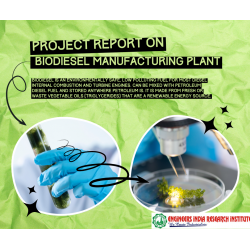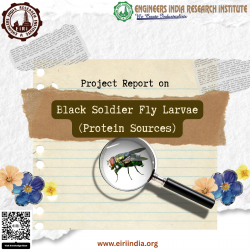Detailed Project Report on biochar production

- More than 45 years of experience
- Managed by expert industrial consultants
- ISO 9001-2015 Certified
- Registered under MSME, UAM No: DL01E0012000
- 24/5 Research Support
Get your quesries resolved from an industry expert. Ask your queries before report or book purchase. - Custom Research Service
Speak to the our consultant to design an exclusive study to serve your research needs. - Quality Assurance
All reports are prepared by highly qualified consultants & verified by a panel of experts. - Information Security
Your personal & confidential information is safe & secure.
BIOCHAR PRODUCTION
[CODE NO.3804]
Biochar is a porous carbonaceous solid material with a high degree of aromatization and strong ant decomposition ability that is produced by the decomposition of biomass from plant or animal waste under limited oxygen conditions. It has received much attention during the last few years for its potential applications in various agronomic and industrial sectors. Biochars have a tremendous range of physical and chemical properties, which greatly affect their wide applications. Recent evidence suggests that the feedstock and the method by which the biochar is produced has a significant impact on biochar characteristics, including concentrations of elemental constituents, density, porosity, and pH, which collectively impact the ability of the biochar for various applications. Inagriculture, it is used to upgrade the soil quality. It slows down the rate of decomposition ofnutrients from the soil and hence, enhances the soil quality. In different industries, it is used in waste treatment to remove organic contaminants, heavy metals and different kinds of dyes and pigments from textile industries. In power generation, biochar can be used as a fuel because biochar contains a high carbon percentage in it which cans beused as fuel.
Biomass has been found to be a very potential source of renewable energy materials and chemicals. The main sources of biomass as a raw material include agricultural residues, algal biomass, forest residues, manures, activated sludge, energy crops, digestate etc. Biomass may be converted into such high-value products using a number of physical, thermo chemical and biochemical processes. Biochar is produced by thermo chemical conversions, such as pyrolysis, gasification, torrefaction, and hydrothermal carbonization of carbonaceous biomass, such as agricultural residues, algal biomass, forest residues, manures, activated sludge, energy crops, digestate etc. at high temperature (300–900°C) and under O2-limiting conditions. The physical, chemical and mechanical properties of biochars depend on the feedstock type and pyrolysis operating conditions. The selection of a specific type of feedstock is to a great extent determined by the availability of this material in the region where the biochar is likely to be produced, as this reduces the cost of transport while decreasing the carbon footprint of the biochar technology. Production of the biochar from the biomass does not only depend upon the technique which is employed to produce but it is also a function of the process parameters involved in the production also. Studies on the biomass pyrolysis in the recent past have revealed that the production of the biochar depends upon several factors such as type of biomass, moisture content, and particle size, reaction conditions (reaction temperature, reaction time, heating rate) and surrounding environment (carrier gas type, flow rate of carrier gas) and other factors (catalyst, reactor type).
Biochar is a carbon rich highly porous substance obtained after pyrolysis of organic biomass. Production of biochar is a sustainable option for waste and disease management. It contains 50% of the original carbon which is highly recalcitrant in nature; therefore its production helps in carbon sequestration by locking the carbon present in the plant biomass. The elemental composition and structural configuration of biochar is strongly correlated with temperature, heating rate and residence time maintained during its production. Along with the biochar some amount of bio-oil and gases are also produced which can be used for generation of energy and various chemicals. Soil pH and electrical conductivity (EC) increase in soil incorporated with biochar which may be due to the presence of ash residue that is dominated by carbonates of alkali and alkaline earth metals, and some amount of silica, heavy metals and organic and inorganic nitrogen. With its large surface area biochar helps in increasing water holding capacity, cation exchange capacity (CEC), microbial activity (act as its habitat) and also reduces leaching of nutrient by providing nutrient binding sites. This reduces the total fertilizer requirement of biochar-amended soil and thereby reduces environmental pollution caused by leaching of inorganic fertiliser. It also plays a vital role in increasing crop productivity. Apart from improving soil quality biochar provides various other benefits such as mitigation of greenhouse gases (e.g. CH4, N2O and CO2), decrease in dissipation rate of herbicide in soil, used as a building material, cleansing agent in cosmetic industry, waste water treatment and food industry. Due to large availability of biomass resources, India has great potential towards production of biochar.
Biochar is a carbon rich charcoal that is formed by the pyrolysis (thermal decomposition) of organic biomass or agricultural residues which is used as soil amendment. It is composed of carbon (C), hydrogen (H), oxygen (O), nitrogen (N), sulphur (S) and ash in different proportions. It is mainly used to improve soil nutrient content and to sequester carbon from the environment. It’s highly porous structure makes it attractive option for soil amendment as it improves water holding capacity of the soil by increasing the total surface area of the soil.
COST ESTIMATION
Plant Capacity 6 Ton/day
Land & Building (2000 sq.mt.) Rs. 2.79 Cr
Plant & Machinery Rs. 1.70 Cr
Working Capital for 2 Month Rs. 87.18 Lac
Total Capital Investment Rs. 5.61 Cr
Rate of Return 23%
Break Even Point 64%
- INTRODUCTION
- RAW MATERIALS
- TABLE: LIGNOCELLULOSIC COMPOSITION (WT%) OF CERTAIN BIOMASS RESOURCES
- PROPERTIES OF BIOCHAR
- EFFECT OF FEEDSTOCK PROPERTIES
- EFFECT OF TEMPERATURE AND HEATING RATE
- CHARACTERISTICS OF BIOCHAR FROM DIFFERENT FEEDSTOCK
- USES AND APPLICATION
- TABLE: ELEMENTAL ANALYSIS OF BIOCHAR PRODUCED FROM
- SOME TYPICAL BIOMASS
- ENVIRONMENTAL APPLICATIONS OF BIOCHAR
- BIOCHAR AS ADSORBENT
- BIOCHAR AS CATALYST
- TABLE: REMOVAL OF ORGANIC POLLUTANTS BY BIOCHAR DERIVED
- FROM DIFFERENT FEEDSTOCKS AND PYROLYSIS TEMPERATURES
- BIOCHAR AS ANIMAL FEED
- AS A TOOL FOR WASTE MANAGEMENT
- AS A SOIL CONDITIONER
- TREATMENT OF WASTE WATER
- BUILDING SECTOR
- COSMETIC INDUSTRIES
- METALLURGY
- FOOD INDUSTRY
- BIOCHAR PRODUCTION IN INDIA
- PRODUCTION PROCESSES FOR BIOCHAR
- THERMOCHEMICAL CONVERSION PROCESSES
- PYROLYSIS PROCESS
- TABLE: OPERATING CONDITIONS OF VARIOUS PYROLYSIS PROCESSES
- AND THEIR PRODUCT FRACTIONS (BIO-OIL, BIOCHAR, AND GAS)
- TORREFACTION PROCESS
- SLOW PYROLYSIS PROCESS
- INTERMEDIATE PYROLYSIS PROCESS
- FAST PYROLYSIS PROCESS
- FLASH PYROLYSIS PROCESS
- HYDROTHERMAL CARBONIZATION PROCESS
- MICROWAVE ASSISTED PYROLYSIS PROCESS
- MANUFACTURING PROCESS OF BIOCHAR
- TECHNIQUE CAN INCLUDE:-
- PROCESS FLOW DIAGRAM
- OPERATIONAL PROCESS FOR BIOCHAR PRODUCTION
- TABLE: CHARACTERIZATION OF CASTOR, COTTON AND PIGEON PEA STALK
- TABLE: COLOR PHASE CORRELATION WITH TEMPERATURE RANGE
- FOR DIFFERENT RESIDUE LOAD AND REACTION TIME DURING
- THERMO-CHEMICAL CONVERSION PROCESS
- PROCESS: THERMO-CHEMICAL CONVERSION OF RESIDUE TO BIOCHAR
- FIG.: SCHEMATIC PRESENTATION OF THE OPERATIONAL PROCESS FOR BIOCHAR PRODUCTION
- DETAILS OF PYROLYSER AND GASIFICATION
- PYROLYSIS
- SLOW PYROLYSIS
- FAST PYROLYSIS
- GASIFICATION
- FATE OF INITIAL FEEDSTOCK MASS BETWEEN PRODUCTS OF PYROLYSIS
- PROCESSES
- CARBONIZATION
- SUMMARY OF PYROLYSIS PROCESSES
- QUALITY CONTROL OF BIOCHAR
- TABLE: MERITS AND DEMERITS OF VARIOUS PYROLYSIS PROCESSES
- ANALYTICAL METHODS FOR BIOCHAR ANALYSIS
- BIOCHAR CONVERSION EFFICIENCY
- COLLECTION, PROCESSING AND ANALYSIS OF BIOCHAR
- PROXIMATE ANALYSIS
- TABLE: VARIOUS ANALYTICAL METHODS FOR BIOCHAR ANALYSIS
- RECOVERY OF TOTAL CARBON AND NITROGEN
- TOTAL C RECOVERY
- TOTAL N RECOVERY
- PROPERTIES OF BIOCHAR
- TABLE: GENERAL PROPERTIES OF BIOCHAR PRODUCED AT THE
- END STAGE OF BIOCARBONIZATION
- BIOCHAR FROM CROP RESIDUES
- A. BIOCHAR YIELD
- B. PROXIMATE ANALYSIS OF BIOCHAR
- TABLE: YIELD AND PROXIMATE ANALYSIS OF BIOCHAR FROM
- DIFFERENT CROP RESIDUES
- BULK DENSITY AND TOTAL POROSITY
- MARKET OVERVIEW OF BIOCHAR
- PRINCIPLES OF PLANT LAYOUT
- PLANT LOCATION FACTORS
- EXPLANATION OF TERMS USED IN THE PROJECT REPORT
- PROJECT IMPLEMENTATION SCHEDULES
- SUPPLIERS OF PLANT AND MACHINERY
- SUPPLIERS OF RAW MATERIALS
APPENDIX – A:
01. PLANT ECONOMICS
02. LAND & BUILDING
03. PLANT AND MACHINERY
04. OTHER FIXED ASSESTS
05. FIXED CAPITAL
06. RAW MATERIAL
07. SALARY AND WAGES
08. UTILITIES AND OVERHEADS
09. TOTAL WORKING CAPITAL
10. TOTAL CAPITAL INVESTMENT
11. COST OF PRODUCTION
12. TURN OVER/ANNUM
13. BREAK EVEN POINT
14. RESOURCES FOR FINANCE
15. INSTALMENT PAYABLE IN 5 YEARS
16. DEPRECIATION CHART FOR 5 YEARS
17. PROFIT ANALYSIS FOR 5 YEARS
18. PROJECTED BALANCE SHEET FOR (5 YEARS)
How to Make Project Report?
Detailed Project Report (DPR) includes Present Market Position and Expected Future Demand, Technology, Manufacturing Process, Investment Opportunity, Plant Economics and Project Financials. comprehensive analysis from industry covering detailed reporting and evaluates the position of the industry by providing insights to the SWOT analysis of the industry.
Each report include Plant Capacity, requirement of Land & Building, Plant & Machinery, Flow Sheet Diagram, Raw Materials detail with suppliers list, Total Capital Investment along with detailed calculation on Rate of Return, Break-Even Analysis and Profitability Analysis. The report also provides a birds eye view of the global industry with details on projected market size and then progresses to evaluate the industry in detail.
We can prepare detailed project report on any industry as per your requirement.
We can also modify the project capacity and project cost as per your requirement. If you are planning to start a business, contact us today.
Detailed Project Report (DPR) gives you access to decisive data such as:
- Market growth drivers
- Factors limiting market growth
- Current market trends
- Market structure
- Key highlights
Overview of key market forces propelling and restraining market growth:
- Up-to-date analyses of market trends and technological improvements
- Pin-point analyses of market competition dynamics to offer you a competitive edge major competitors
- An array of graphics, BEP analysis of major industry segments
- Detailed analyses of industry trends
- A well-defined technological growth with an impact-analysis
- A clear understanding of the competitive landscape and key product segments
Need Customized Project Report?
- Ask for FREE project related details with our consultant/industry expert.
- Share your specific research requirements for customized project report.
- Request for due diligence and consumer centric studies.
- Still haven't found what you're looking for? Speak to our Custom Research Team
About Engineers India Research Institute:
Note: We can also prepare project report on any subject based on your requirement and country. If you need, we can modify the project capacity and project cost based on your requirement.
Our Clients

Our Approach
- Our research reports comprehensively cover Indian markets (can be modified as per your country), present investigation, standpoint and gauge for a time of five years*.
- The market conjectures are produced on the premise of optional research and are cross-accepted through associations with the business players
- We use dependable wellsprings of data and databases. What's more, data from such sources is handled by us and incorporated into the report
Why buy EIRI reports?
- Our project reports include detailed analysis that help to get industry Present Market Position and Expected Future Demand.
- Offer real analysis driving variables for the business and most recent business sector patterns in the business
- This report comprehends the present status of the business by clarifying a complete SWOT examination and investigation of the interest supply circumstance
- Report gives investigation and top to bottom money related correlation of real players/competitors
- The report gives gauges of key parameters which foresees the business execution

























